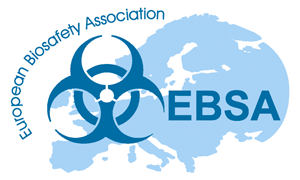About EBSA07 Conference - Prague
EBSA07 Conference - Prague
Biosafety risk assessment, containment and safe disposal
Programme
THURSDAY, 13 MAY 2004
| Registration | 08.00 |
| Trends in Containment Lab Design | 08.15 - 09.30 |
| Breakfast workshop sponsored by CUH2A | |
| Welcome by EBSA President Kathrin Bernard | 09.30-09.40 |
| Session 1: Risk Assessment, (re)emerging diseases | 09.40-10.35 |
| Chair: Prof. Ing. Jan Kas, DrSc., Dept. of Biochemistry and Microbiology, Institute of Chemical Technology, Prague Emerging Viral Infections, what is the risk and are we prepared? |
|
| Break | 10.35-11.05 |
| Session 2: Risk Assessment - Concurrent Breakout Sessions (discussion groups) | |
| Session 2 A: Animal risk assessment | 11.05-12.30 |
| Moderator: Dr. Kathrin Bernard, Institute for Virology and Immunoprophylaxis, Berne, Switzerland
Work in biocontainment facilities involving animals must include continuous and rational risk assessment. The basic elements include understanding the biology of the agents and the potential hazards associated with non-infected or infected animals. Physical and biological hazards should be assessed and appropriate safety measures should be taken. This breakout session will focus on how hazardous agents can be prevented from spreading from experimentally or naturally infected animals to other animals or to people. |
|
| Session 2 B: GMO Risk Assessment | 11.05-12.30 |
| Moderator: Dr. Gary Burns, AstraZeneca , UK
This will be an interactive session addressing risk assessment of work involving genetically modified organisms within the context of European Council Directive 98/81/EC. Among the issues to be addressed will be: |
|
| Session 2 C: Large Scale Risk Assessment | 11.05-12.30 |
| Moderator: Dr. Otto Doblhoff, Igeneon, Austria
The discussion will focus on, but will not be limited to: |
|
| Session 2D: Transport Risk Assessment | 11.05-12.30 |
| Moderator: Nicholas Mohr, Peter East Associates, UK Speakers: Janet Cox, Roche, UK and Sue Lee, World Courier, UK This session will address the key issues relating to the transport of diagnostic, clinical and infectious specimens as they impact the shippers, intermediaries and airlines. The regulations for classification, packaging, documentation, acceptance by carriers as well as temperature control have developed in response to risk assessment. Yet, do all the participants in the transport chain have a similar understanding of the risks. What are the risks involved with international transport? Are major changes in the regulations effective from January 2005 based on sound principles of risk assessment? And finally, does training play any relevant role in mitigating the risk inherent in transport? There will some short presentations followed by a discussion of the issues raised. |
|
| Managing Biosafety - Insights From Other Major Hazard Industries | 12.30 - 14.00 |
| Luncheon workshop sponsored by DNV | |
| Session 3: Containment Principles - Laboratory Versus Hospital Settings | 14.00 - 15.00 |
| Laboratory Containment Measures for Mycobacterium tuberculosis Alan Rayner, Chief Biomedical scientist, Scottish Mycobacteria reference Laboratory, Royal infirmary of Edinburgh, UK |
14.00 - 14.30 |
| Worker protection against M. tuberculosis in patient care, diagnosis and pathology Dr. Juergen Mertsching, Biosafety Officer, Hannover Medical School, Germany |
14.30-15.00 |
| Break | 15.00 - 15.30 |
| Session 4: Containment Principles - Monitoring for Exposure Convener: Esmeralda Prat, Bayer CropScience, Belgium Chair: Stefan Wagener, CSCHAH, Winnipeg, Canada |
15.30 - 17.00 |
| Introduction: Why monitor? Stefan Wagener, CSCHAH, Winnipeg, Canada |
15.30-15.35 |
|
Monitoring viral contaminations in laboratories during biosafety inspections |
15.35-16.00 |
| Monitoring bacteria and yeast in the laboratory Jan-Piet Tijssen, VROM-Inspectorate, Haarlem, The Netherlands |
16.00-16.25 |
| Quantification of aerosol generation in laboratory procedures and the potential worker exposure Allan Bennett, Health Protection Agency, Salisbury, UK |
16.25- 16.50 |
|
Discussion: meaning of results Lead by Stefan Wagener |
16.50-17.00 |
| ANNUAL GENERAL MEETING for EBSA Members only | 17.00 - 18.00 |
|
CONFERENCE RECEPTION AND DINNER Pick-up at hotel - Timetable: see EBSA welcome desk |
20.00 |
FRIDAY, 14 May 2004
| Session 5: Waste Management Chair: Mr. Robert Osborne, University of Glasgow, UK |
09.00-10.00 |
| Management of Infectious Waste Ms Wendy Rayner, Enviros Consulting Ltd, Edinburgh Office: 61 The Shore, Leith. Edinburgh, UK |
09.00-09.30 |
| Waste water management in biopharmaceutical production Dr. Roman Necina, Head of Biotech Production, Boehringer Ingelheim Austria, Vienna |
09.30-10.00 |
| Break and Poster session | 10.00-11:00 |
| Session 5: Waste Management (continued) | 11.00-11.30 |
| New and Emerging Technologies for Clinical Waste Disposal Dr. M.G. Holliday, Microbiology Department, Newcastle-upon Tyne Hospitals NHS Trust |
|
| Session 6: Chris Collins Lecture | 11.30-12.15 |
| Investigation of 1918 Spanish flu using permafrost burials and pathology lung blocks Dr. Rod Daniels, National Institute for Medical Research, London, UK |
|
| Closure by the EBSA president 2004-2005 Prof. Helmut Bachmayer | 12.15 |
| Sandwich Lunch | 12.30-13.00 |
